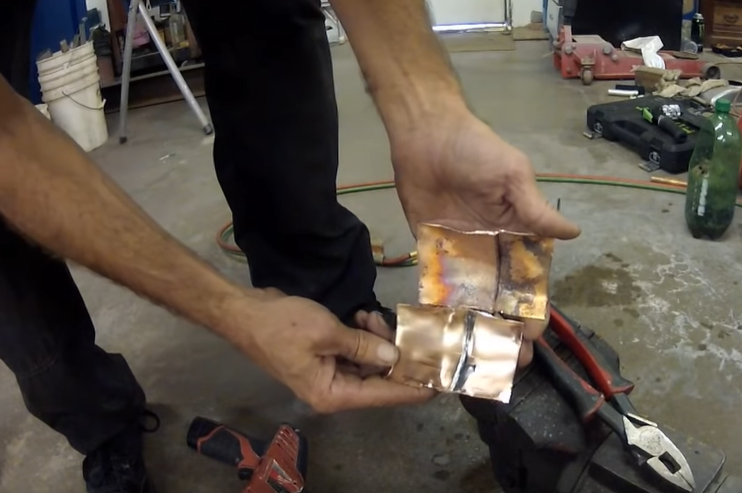How To Braze Ac Line Set
Become Tech Tips
Subscribe to complimentary tech tips.
How (and Why) to Catamenia Nitrogen While Brazing

When I started in the trade, the thought of flowing nitrogen while brazing was nothing more than than the punchline of a joke. Like pulling a vacuum with a micron gauge or proper recovery, it was a wink and nod proposition rather than a existent exercise. I've had to unlearn many bad habits since those early days, and the practice of flowing nitrogen while brazing is one that I however hear beingness mocked every bit "overkill" by old-timers. Information technology isn't hard, it isn't overkill, and it makes a Large difference. If you just keep reading instead of rolling your eyes, I will tell you the reasons why.

What Flowing Nitrogen Accomplishes
Copper and oxygen react to create "cupric oxide," or copper oxide, similar to how iron and oxygen react to create rust. When we heat copper over about 500°, this begins to occur rapidly. As heat and oxygen increase, yous'll see more copper oxide scale building up. We see this occur all the fourth dimension on the Exterior of the copper, where oxygen is prevalent in the air, though this tin as well occur within the copper if at that place is air inside the arrangement rather than dry out nitrogen. It's made worse when the joint is hotter and when y'all go out the copper open up to the air for longer periods while working. When nosotros prevent air from entering the lines in the kickoff identify by keeping them sealed as much equally possible so flow nitrogen while brazing, we tin can prevent copper oxide from forming—this practice keeps line filter/driers, screens, compressor oil, and valves (e'er heard of a bad TXV?) gratuitous from contamination and prevents many bug. Non to mention, it Also helps speed up the evacuation procedure.

Why Old-Timers Say it Doesn't Affair
Many techs who have done this piece of work for a long time oasis't flowed nitrogen EVER and have gotten abroad with it because of mineral oil. Older Cfc and HCFC refrigerants used mineral oil rather than POE/PVE or PAG oils that we come across today, which accept higher solvent properties that "scrub" the oxide from the walls and deposit it into driers and screens. Techs in the grocery industry know that when a organization is converted from mineral or AB oil over to POE, it is very common for this cupric scale to clog screens pretty chop-chop afterward the changeover. The bespeak hither is that mineral oil was forgiving on small amounts of cupric oxide on the tubing walls, merely POE isn't.
The Process
Keeping copper oxide out of the arrangement is actually quite like shooting fish in a barrel with a mutual-sense approach in place, starting with just pulling the nitrogen tank and flow regulator off of the truck, along with the torches, Beginning Affair. There are several bang-up flow regulators on the market place—a few built right into the regulator and some that you lot adhere to the outlet of the regulator. Go on in heed that y'all need to FLOW nitrogen, not PRESSURIZE with nitrogen while brazing. Otherwise, you never become the joints to hold.
- REMOVE CORES – When you set, you outset need to remove your cores in the inlet and outlet of the brazing path so that you lot can get total period with minimum backpressure.
- PURGE OUT AIR –Purge nitrogen at fairly high pressure in the direction of the refrigerant flow to help "chase" the air out of the circuit and fill up it with nitrogen.
- FLOW WITH ii-five SCFH – Menses with a VERY LOW flow of 2-5 standard cubic feet per hr of flow, which is just a whisper out the cease.
- DON'T FREAK OUT –The very last joint can be tough on pocket-size systems. It's OK if you close off the flow or reduce it downwardly to next to nada for that last joint. Don't make beingness "perfect" the enemy of getting started flowing nitrogen while brazing. Don't overthink it, and cease making excuses for not doing information technology.
If you follow this process and and so pressure examination with nitrogen before evacuation, it will go much more smoothly. All in all, it can save you time in the procedure. Nitrogen is cheaper than callbacks and early component failure. Use it.
If yous need any more convincing or merely want to larn more well-nigh flowing nitrogen, requite this commodity a read or watch this video.
—Bryan
 Related Tech Tips
Related Tech Tips
 Oxidizers and What It Has to Practise With COVID-19
Oxidizers and What It Has to Practise With COVID-19
Oxidation is the loss of electrons, reduction is the gain of electrons, and the reaction is what occurs between the two. When we talk about chemistry or chemical reactions, we are really talking about an electrical interaction betwixt molecules seeking equilibrium. In other the words, the old "high voltage goes to low voltage" rule applies […]
Read more
 You're Grounded
You're Grounded
1 of the near mutual questions nosotros go from techs is near using a voltmeter to diagnose a high voltage circuit. Information technology'southward especially tricky when a tech is used to working on a low-voltage or 120V circuit, where there is a clear "hot" side of the circuit and a clear "grounded" side of the circuit. […]
Read more
 Sensible Heat in Air and Water
Sensible Heat in Air and Water
Here is another great explanation from Michael Housh of Housh Home Free energy in Ohio. Thank you, Michael! I'm going to lay out and compare the sensible heat rate equations for both the air-side and water-side of HVAC to assist draw similarities and dive deeper into the scientific discipline behind these equations. This is the showtime of a […]
Read more
Source: https://hvacrschool.com/how-and-why-to-flow-nitrogen-while-brazing/


0 Response to "How To Braze Ac Line Set"
Post a Comment